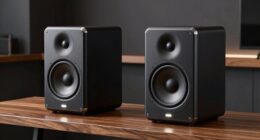As you delve into learning about the complexities of Deaf culture, take into account the significant influence of language and communication.
The nuances of this vibrant community's values, beliefs, customs, and traditions are woven into the very fabric of their identity.
Exploring the historical roots and evolution of Deaf culture unveils a rich tapestry of resilience and unity.
Stay tuned to uncover the dynamic dynamics of Deaf communities and the diverse identities that shape their world.
Key Takeaways
- American Sign Language (ASL) is central to Deaf culture for communication and expression.
- Deaf culture values socializing, art, and community connections.
- Understanding the history and evolution is vital to appreciating Deaf culture.
- Membership in the Deaf community is based on sign language proficiency and involvement.
Language and Communication
If you want to truly understand Deaf culture, grasp the fundamental importance of American Sign Language (ASL) as the primary language for communication and cultural expression. ASL isn't just a mode of communication for the Deaf; it's a cornerstone of their identity and community. Utilizing ASL allows Deaf individuals to express themselves fully, share stories, and connect on a deeper level within their culture.
Within ASL, communication goes beyond just hand movements. Eye contact, facial expressions, and body movements are essential components that convey meaning and emotion. These elements enrich conversations, adding depth and nuance to interactions. ASL vlogs have become a popular medium for Deaf individuals to communicate, share experiences, and build connections within the community.
Values and Beliefs

Embrace the core values and beliefs that shape the vibrant tapestry of Deaf culture, where sign language, especially ASL, is revered as the natural language for effective communication and a fundamental aspect of identity. Preserving ASL stands as a key belief, highlighting its significance in social interactions and personal expression. Socializing holds immense value within the Deaf community, fostering connections and a strong sense of belonging.
Deaf culture celebrates art, poetry, stories, and media created by Deaf individuals, showcasing unique creativity and profound expression. Through ASL interpretation of songs, music becomes a powerful tool for cultural expression and unity within the Deaf community. These values and beliefs not only enrich the lives of Deaf individuals but also promote a deep appreciation for the diverse forms of communication and art that contribute to the rich tapestry of Deaf culture. Embrace these principles, for they're the heart and soul of a community built on connection, expression, and shared identity.
Cultural Customs and Traditions

Immerse yourself in the vibrant tapestry of Deaf culture through its rich cultural customs and traditions that emphasize social connections and a deep sense of cultural identity.
- Deaf people value socializing and gatherings as a key cultural tradition.
- Participation in Deaf events and Deaflympics supports social interactions within the community.
- Deaf culture promotes a sense of pride in being Deaf, emphasizing cultural identity.
- Traditional introductions among Deaf individuals include sharing full names, city of origin, and school attended.
- The use of labels like Big 'D' Deaf and little 'd' deaf signify involvement in Deaf culture and hearing loss, respectively.
In Deaf culture, these customs and traditions are more than just rituals; they're the threads that weave together a strong community bond.
History and Evolution

Delve into the captivating journey of Deaf culture's history and evolution, a narrative steeped in resilience, advocacy, and the relentless pursuit of recognition and equality. The term 'Deaf culture' emerged in the 1960s, signifying a unique cultural group with its own customs and traditions. However, it was the groundbreaking 1988 Deaf President Now movement at Gallaudet University that truly highlighted the significance of Deaf culture. Gallaudet University stands as a beacon for the Deaf community, embodying the essence of Deaf culture and identity.
Understanding the history of Deaf culture is essential to grasp its evolution and distinctive features. Throughout its history, Deaf culture has demonstrated unwavering resilience in the face of adversity, advocating for its recognition and striving for equality. The journey of Deaf culture is a testament to the strength and perseverance of a community that continues to shape its identity and pave the way for a more inclusive society.
Community Dynamics and Identities

As we explore the realm of Deaf culture further, understanding the dynamics of its community and identities unveils a rich tapestry woven with shared sign languages, cultural norms, and a deep sense of belonging. Within the Deaf community, membership isn't just about hearing loss; it's about embracing a unique culture and language.
Here are some key points to consider:
- Deaf communities are united by shared sign languages and cultural norms.
- Membership in the Deaf community is based on self-identification and involvement.
- Proficiency in sign language is often a key factor in acceptance within the Deaf community.
- Family members, interpreters, and allies can be part of the Deaf community.
- Social connections with Deaf individuals can lead to a deeper understanding and identification with Deaf culture.
Whether you're a member of the Deaf community or an ally, recognizing the importance of sign language, cultural norms, and social connections can foster a stronger sense of identity and belonging within this vibrant community.
Frequently Asked Questions
What Are the Basics of Deaf Culture?
Explore the rich tapestry of Deaf culture, rooted in American Sign Language. Its essence lies in social bonds, pride in identity, and artistic expression. Nonverbal nuances are key, enhancing communication through visual poetry and vibrant community connections.
What Are the 5 Aspects of Deaf Culture?
Explore Deaf culture through the lens of American Sign Language, social gatherings, artistic expressions, and nuanced communication. Immerse yourself in a world where eye contact, facial expressions, and body language speak volumes.
What Are the Four 4 Core Values of Deaf Culture?
In Deaf culture, the core values are collectivism, respect, direct communication, and visual communication. These values emphasize community, honoring individuals, honesty, and reliance on visual cues. They shape the vibrant and connected Deaf community.
What Are 4 Cultural Behaviors in the Deaf Culture?
Focus on facial expressions, eye contact, body language, and visual attention in Deaf culture. These cultural behaviors enhance ASL communication, adding depth and richness to conversations. Embrace these nuances to truly connect and respect the Deaf community.
How Does Understanding Deaf Culture Contribute to Empowering Deaf Individuals in Their Independent Living Strategies?
Understanding deaf culture is crucial for empowering deaf individuals in their independent living strategies. By embracing the unique language, social norms, and values of the deaf community, individuals can better support and advocate for the needs and rights of empowering deaf individuals: independent living.
Conclusion
Now that you have explored the vibrant world of Deaf culture, you have gained a new perspective on the richness and diversity of this community.
Embrace the beauty of sign language, the strength of shared values, and the resilience of Deaf individuals throughout history.
Let your heart be touched by the deep connections and sense of belonging within this unique culture.
Keep learning, keep listening, and keep celebrating the beauty of Deaf culture.











